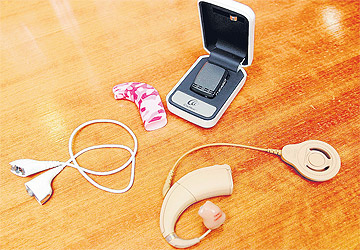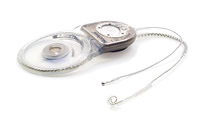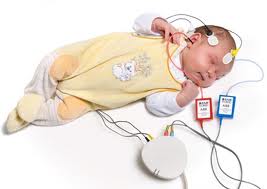Introduction
According to the statistics of the World Health Organization (WHO), three out of 1,000 babies are born with a hearing impairment. Hearing problems usually affect the individual’s ability to listen and speak thus impairs their involvement in the community.
Cochlear implant (CI) gives hope for individuals with hearing problem. Cochlear implant, also known as bionic ear is one of the latest methods in helping individuals with hearing problem. This sophisticated high-tech device is able to assist individuals who have hearing problem to recognize, hear and produce speech.
The Ministry of Health Malaysia launched a cochlear implant program in the year 2006 to help patients get this treatment.
About Cochlear Implant
 |
| Source : Berita Harian Online |
Cochlear implant (CI) is an electronic device implanted in the head through surgery in order to help people who have sensorineural hearing problems to hear.
The function of the cochlear implant is different from a hearing aid, in which the hearing aid is used to amplify the sound, while the cochlear implant helps to replace the function of the damaged inner ear to process sound and sends signals to the brain.
Cochlear Implant Components
The basic compenent for the Cochlear implant is divided into two sections :-
 |
 |
| Inner Content: Implant and Electrode Lines | Outer Content: Sound Processor |
| Source : Advanced Bionics | |
How to hear with Cochlear Implants
- The sound is collected through the microphone in the sound processor.
- The sound process converts sound into digital information.
- The magnetic head set send the digital information to the implant.
- The electrode lines send the electric signal to the hearing nerve.
- The hearing nerve sends it to the brain where it will be interpreted as sound.
 |
| Source : Advanced Bionics |
Suitable Candidates for Cochlea Implants
The selection criteria for Cochlear implant are as follows:-
Candidate’s Age
- Children that have hearing problems before speaking has to be below the aged of four. However, patients that are above the age of four can still be considered based on agreed condition.
- There is no maximum age limit for adult patients and children who already speaking before having hearing impairment.
Hearing Impairment
- Patients with profound sensorineural hearing at both ears.
Hearing Aid Trial
- Patient has used hearing aids consistently within the stipulated time but are not benefiting from it.
Patient Health Level
- The patient does not have absence of auditory nerve
- The patient does not have other health problems that can prevent patients from surgery.
Involvement of patients and caregivers
- Patient has good attention and co-operation during evaluation and therapy sessions
- Patients and caregivers give their commitment to treatment sessions
Cochlear Implant Intervention Process
Cochlear implantation process is an intervention that requires the involvement of a multidisciplinary team with a number of specialized services:
- ORL Surgeon
- Audiologist
- Speech-language therapist
|
Otolaryngologist Specialist
|
Otolaryngologist Specialist performs the initial examination to check the health of the patient before surgery and performs surgery. |
|
Audiology Service
|
The Audiologist checks the hearing level of the patient, installation of the hearing aid and performs rehabilitation after the Cochlear implant. |
|
Speech Language Therapist Service
|
Speech Language therapist performs speech and language rehabilitation before and after surgery to improve on patient’s communication ability. |
Patients must undergo intervention before and after the cochlear implant surgery. It is a process that must be undertaken in stages and continuously to ensure the effectiveness of this device. The treatment processes are as follows:
- The patient must undergo a hearing test with the audiologist to determine the type and the severity of the hearing loss.
- Patients identified as having hearing problems should use hearing aids consistently within the stipulated time.
- At the same time patients have to undergo speech therapy with speech-language therapists to learn the skills of listening and speaking.
- Audiologist and speech-language therapists will assess whether patients benefited from the use of hearing aids.
- Patients should undergo joint examination by ORL Specialists , Pediatricians, Radiological or any other medical experts if necessary to assess whether the patient is suitable to undergo cochlear implant surgery .
- Patients identifies as suitable will undergo the surgery that is to be performed by ORL specialists.
- The cochlear implant will be activated between 2 – 4 weeks after the surgery.
- The patient will then have to undergo a mapping session with the Audiologist.
- The patient will also undergo speech therapy session to improve the skills of listening and speaking.
Cochlear Implant Usage Effects
Cochlear implant is not a magical tool that can restore hearing in patients immediately. The rehabilitation process after the cochlear implant surgery requires hard work and continued commitment from the therapists, patients and caregivers. The patient’s ability to hear and speak using the cochlear implant depends on several factors :-
- Duration that the patient can’t hear
- Condition of the patient’s ear
- Other health problems faced by the patient
- Acceptance and cooperation of the patient in the process of rehabilitation after the surgery
The National Cochlear Implant Program by Ministry of Health Malaysia
The National Cochlear Implant program by the Ministry of Health Malaysia was launched in 2006 to ensure that patients with hearing problems that have the potential, to get the best treatment interventions in order to maximize their hearing and speech abilities. It was also launched to ensure that cochlear implant surgery can be carried out systematically, safely and effectively.
There are a number of hospitals that have been selected as a satellite hospital for the implementation of this program. Hospitals are divided following zones as listed below :
Northern Zone
- Hospital Sultanah Bahiyah, Alor Setar Kedah
-
Hospital Raja Perempuan Bainun, Ipoh, Perak
Western Zone
- Hospital Kuala Lumpur, Wilayah Persekutuan Kuala Lumpur
- Hospital Sungai Buloh, Selangor
Southern Zone
- Hospital Tuanku Ja’afar, Seremban, Negeri Sembilan
- Hospital Sultan Ismail, Pandan Johor
Eastern Zone
- Hospital Raja Perempuan Zainab II, Kota Bharu, Kelantan
- Hospital Sultanah Nur Zahirah, Kuala Terengganu, Terengganu
- Hospital Queen Elizabeth, Kota Kinabalu, Sabah
References
- Richard C. Dowell (2005). The Hearing Journal. Evaluating Cochlear Implan Candidacy: Recent Development. 58. 9-22
- Medical Service Development Section & Drafting Commitee of Operational Policy of Cochlear Implant Service (2009). Cochlear Implant Service Operational Policies. (MOH/P/PAK/181.09(BP)). Ministry of Health
- Siti Nuralmizan Ariffin (November 2012).Implan Koklea. Berita Harian. Retreived from http//www.bharian.com.my/articles/Implankoklea/Article
- Advances Bionics, LLC (2013). Gangguan Pendengaran & Implan Koklea. Retreived from http//www.advancedbionics.com.my
- ASHA (1997-2014). Hearing Aids, Cochlear Implan & Asistive Technology. Retreived from http//www.asha.org/public/hearing/Cochlear-Implan
- Cochlear South East Asia. Cochlear Implan & My Child was Born Deaf. Retreived from http//www.cochlear.com/wps/wcm/connect/intt
| Last Reviewed | : | 28 August 2020 |
| Writer / Translator | : | Marina bt. Abdul Malek |
| Accreditor | : | Zaidi bin Ya’acob |
| Reviewer | : | Nadwah bt. Onwi |










